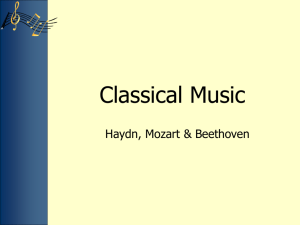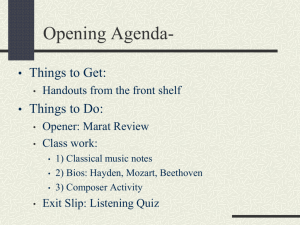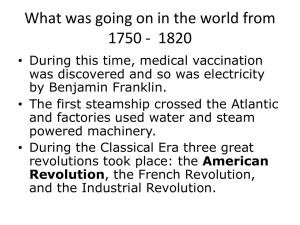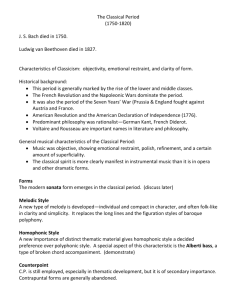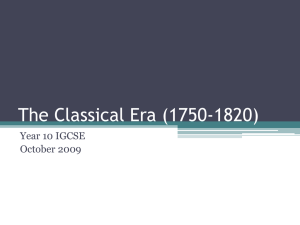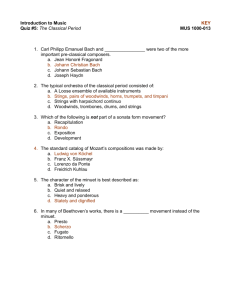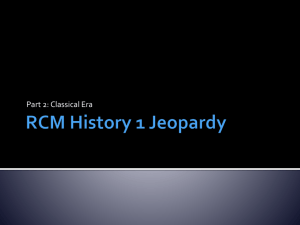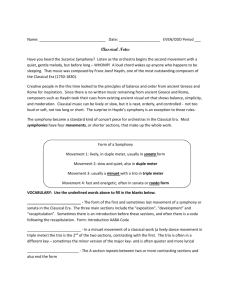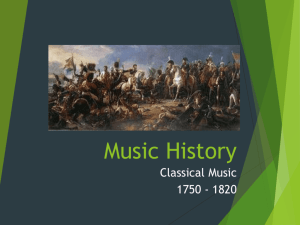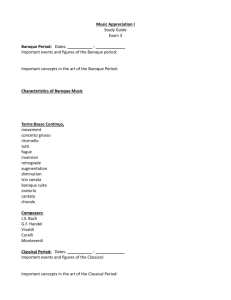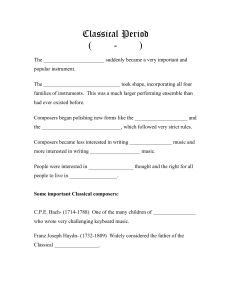The Classical Era
advertisement
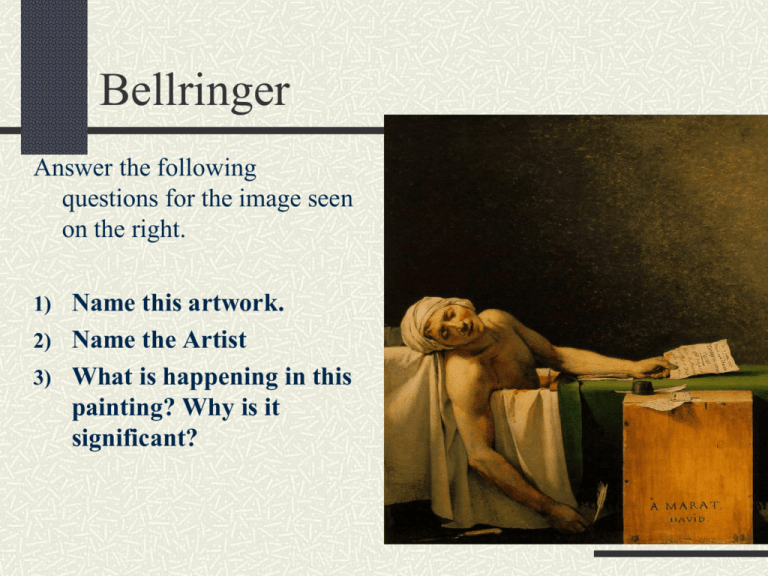
Bellringer Answer the following questions for the image seen on the right. 1) Name this artwork. 2) Name the Artist 3) What is happening in this painting? Why is it significant? Bellringer- 1) The Death of Marat 2) by Jacques Louis David 3) Journalist in bathtub, sent hundreds to the guillotine, Charlotte Corday wanted to save her country, stabbed Marat to end Reign of Terror The Classical EraClassical Music BEAUTY IS FOUND IN ORDER AND SYMMETRY 1750-1825 Copyright © 2005 - Frankel Consulting Services, Inc. Classical Music Baroque music was too religious and dramatic. Distinguished by the growth of popular audience for serious music. Vienna, Austria was the center of classical music As public concerts became more popular in the 18th century, the average person’s experience with and appreciation for music increased. Adopted Neoclassical ideals of order, symmetry and equality (sort of) Composers gained fame by reshaping old forms like the concerto and establishing new forms (symphony) Classical Music Patronage Often commissioned by aristocratic EVERYDAY families, rather than royalty or nobility Supported themselves by offering music lessons, printing books of instruction, and writing simple pieces to be played at home Not as rich, but free in composition http://oboeclassics.com/~oboe3583/ambache/wMartinez.htm Classical Music Women Made music in the home to entertain families, suitors, and close friends Traditional instrument in the home: Harpsichord Professional Musicians for the first time: Marianna Martinez (1744-1812) Studied with Haydn Full length works earned her acclaim Classical Music Characteristics: References to Greco-Roman Art, clarity of form, balanced design, emotional restraint How did music change? Form: order, symmetry, clarity Timbre: New/more instruments = more instrumental music Texture: Polyphony gives way to Homophony Melody: distinct patterns and duality Dynamics: Changes more subtle and dramatic Types: sonata, string quartet, symphony, overture. Symphony Four parts that follow a predictable pattern An extended work for orchestra - 20 - 40 min. in length. Characteristics of Form: First Movement: Allegro-Dramatic Uses the sonata-allegro form Second Movement: Adagio/Andante- Reflective Theme and variation/rondo/sonata-allegro Third Movement: Moderato (popular dance)- Stately and Elegant Minuet/trio (ABA) Fourth Movement: Allegro- Happy Sonata-allegro form The Sonata This word is used in two different ways: A one-movement piece for a solo instrument, usually accompanied by a piano Sonata allegro form (first movement of a symphony)Exposition Introduces themes Development Modifies themes Recapitulation Returns to the main theme The String Quartet A composition for four solo string instruments: 2 Violins 1 Viola 1 Cello Each part is equally important. Haydn was the first to write one - he also mastered them. Piece usually has four movements similar to that of the symphonic form. Opera Opera is a combination of music, drama, scenery, costumes, dance, etc., to create a complete art form. During this period and the one that followed that most of the most famous operas were written including: The Magic Flute The Marriage of Figaro Don Giovanni Mozart Instruments of the Classical Period Modern Flute Clarinet French Horn Valved Trumpet Trombone Percussion Piano Famous Classical Composers Haydn Mozart Beethoven Franz Joseph Haydn1732-1809 -Court musician for Prince Esterhazy for 30 years -When Esterhazy died in 1790, son disbanded orchestra. -Moved from Vienna to England in 1791 -Received at Royal Court -Awarded an honorary doctorate at Oxford -Began to receive financial benefits -Here he wrote “London Symphonies” -“Papa Haydn” -Basic form of sonata, symphony, and string quartet -Wrote more than 100 symphonies HaydnSurprise Symphony Characteristics of music: - - clarity, balance, restraint Set guidelines for classical style while adapting to patron’s needs Transition from court to public music - Song to Identify : - Surprise Symphony Wolfgang Amadeus Mozart Wolfgang Amadeus Mozart1756-1791 -Born and raised in Salzburg -Father was first music teacher -Child prodigy -Played the violin and piano at the AGE OF FIVE!!!! -As an adult -Suffered from depression and illness -Difficult time securing an income -Wrote more than 600 works -41 symphonies, 27 piano concertos, nine concertos -Died at 35 in serious debt Mozart- Requiem Mass -Characteristics of Work: -Combination of German and Italian styles -Shows a wide range of emotions -Wrote some of the most famous operas, still performed A LOT: -The Marriage of Figaro -The Magic Flute -Don Giovanni -Song to Identify : - Requiem Mass-Lacrimosa - Composed: 1791 (In Vienna) - Most enigmatic pieces of music ever composed, unfinished before Mozart’s death. http://www.youtube.com/watch?v=JE2muDZksP4 Ludwig Von Beethoven 1770-1827 Ludwig Von Beethoven 1770-1827 Born and raised in Bonn, Germany Had to practice late at night for a drunken father 21- moved to Vienna and remained there Known as prodigy on piano and his improvisational skills Innovative and creative composer: Changes music from being a function of objective laws to music that expresses one’s inner feelings Supported himself solely through composing and performing his music 1800: starts going deaf/1815- mostly deaf Nearly commits suicide (1802- Heiligenstadt testament) Beethoven Characteristics of Work: 32 sonatas, nine symphonies Tension between Classical and Romantic Three periods Until 1802: Classical style Stuck to Haydn’s rules Middle Period (1803-14): “Heroic Phase” Works are more dramatic, longer, stretch Classical form Compositions modulate between gentile and appealing melodies and dynamic and forceful writing* Final Period (1815-1827) New music territory and spiritual profundity Beethoven- Moonlight Sonata Composed: 1801 Form: Sonata (piano) * does not follow the traditional sonata pattern Additional information: - Three movements: Adagio sostenuto: written in truncated sonata form where the melody is played mostly by the right hand. - Pianissimo to mezzo-forte. Allegretto: is a relatively conventional minuet and trio; a moment of relative calm written in D-flat major. Presto agitato: The stormy final movement (C-sharp minor), in sonata form, is the weightiest of the three Classical Composers Activity Composers Assignments: Assignment One: Mind Map Assignment Two: Sensory Figure Complete one and two on any composer of your choice. Write a summarizing statement of how the composer you left out relates to the others. Conclusions Most of the most famous composers in history come from this era. By 1825, the modern orchestra was almost fully in place (except for the tuba and low woodwinds). It was during this era that many of the most famous pieces of music were written, including symphonies and operas. Exit Slip On Opener, Article Sheet 1) Name one fact (composer) and one characteristic (music) of the following composers: Haydn, Mozart, Beethoven 2) Listening Quiz: composer and song title 1) 2) 3) 4) 5) 6) 7 8 9

